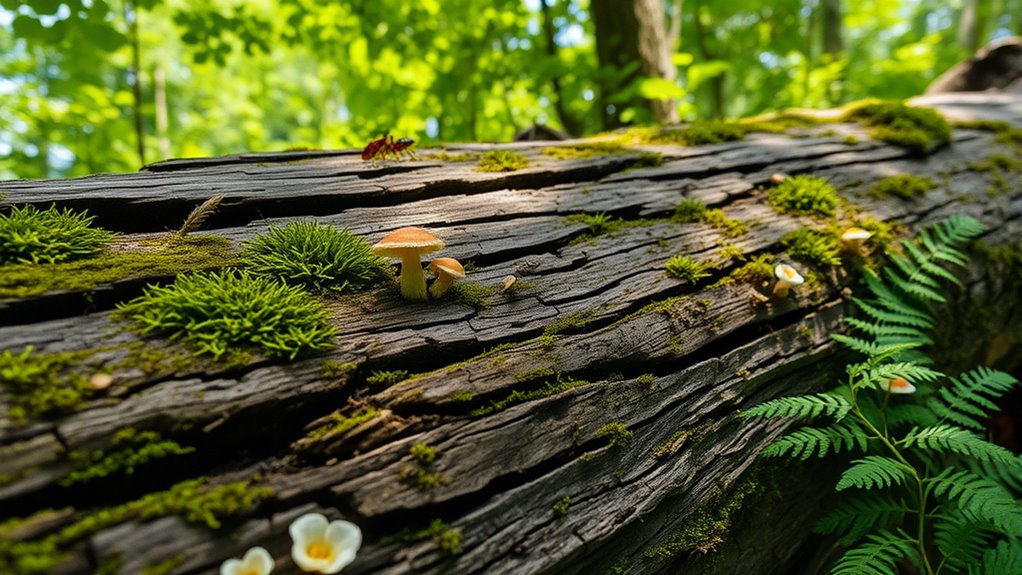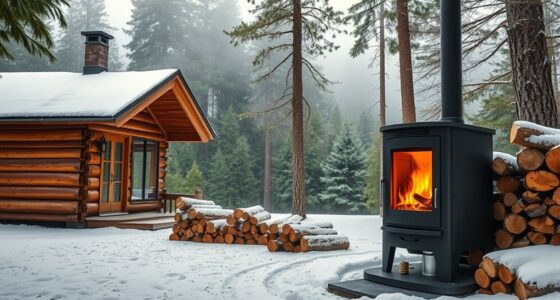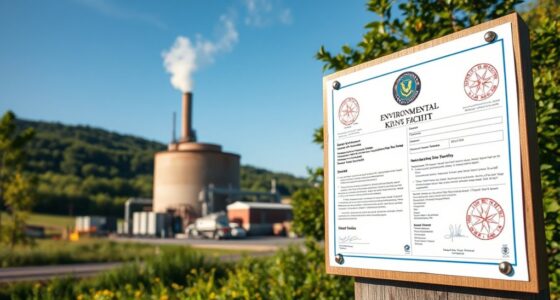Deadwood plays a crucial role in forest ecosystems by supporting decomposition, which recycles nutrients and helps store carbon, reducing climate change impacts. It provides essential habitats for fungi, insects, and other creatures, promoting biodiversity and ecosystem stability. Deadwood also improves soil fertility through nutrient release and offers shelter from predators and weather. If you’re curious about how natural decay maintains forest health and resilience, keep exploring these fascinating ecological functions.
Key Takeaways
- Deadwood facilitates fungal decomposition, recycling nutrients and supporting microbial diversity in forest soils.
- It acts as a habitat for insects, fungi, and other organisms, promoting biodiversity and ecosystem stability.
- Decomposing deadwood releases essential nutrients, enhancing soil fertility and supporting plant growth.
- It contributes to carbon storage, mitigating climate change and maintaining ecosystem resilience.
- Proper deadwood management balances ecological benefits with risks like pests and fire hazards.
The Ecological Functions of Deadwood
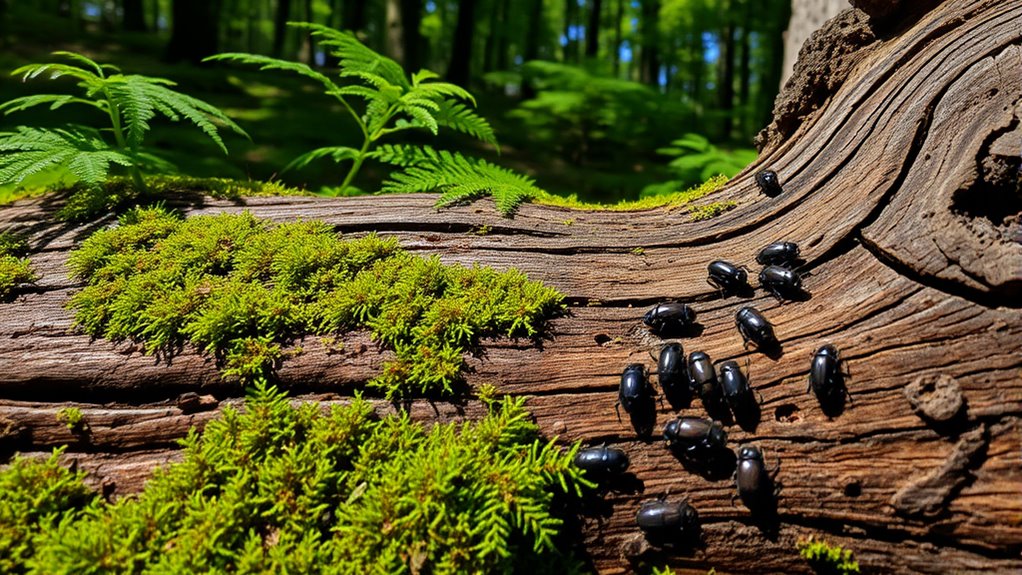
Have you ever wondered why deadwood is essential to forest health? It plays a key role in fungal decomposition, breaking down complex organic materials and recycling nutrients back into the soil. This process supports soil fertility and promotes new plant growth. Deadwood also acts as a crucial carbon storage unit, trapping carbon within its woody structure and preventing its release into the atmosphere. By storing carbon, deadwood helps mitigate climate change and maintain ecosystem balance. The fungi that decompose deadwood create a dynamic environment, fostering microbial diversity and nutrient cycling. Without deadwood, forests would lose a vital component of their nutrient and carbon budgets, weakening overall ecosystem resilience. Its ecological functions are fundamental to sustaining healthy, productive forests. Additionally, native plant cultivation can be used to cultivate native plants that thrive in deadwood-rich environments, further supporting forest regeneration. Recognizing the importance of deadwood underscores its role in maintaining ecosystem stability and resilience against environmental stresses. This ongoing decomposition process also plays a part in biodiversity conservation, supporting a wide range of organisms that depend on deadwood habitats. Furthermore, the presence of deadwood influences animal habitats, providing shelter and food sources for various species.
Deadwood as Habitat and Shelter

Deadwood not only contributes to nutrient cycling and carbon storage but also provides essential habitat and shelter for a wide range of forest organisms. As you explore the forest, you’ll notice how deadwood supports fungus diversity, offering a substrate for fungi to thrive and decompose. This process creates microhabitats that benefit various insects, such as beetles and termites, which burrow into or live on decaying wood. Deadwood’s complex structure offers protection from predators and harsh weather conditions, making it a crucial refuge for many species. By maintaining a healthy amount of deadwood, you ensure that these habitats remain available, supporting biodiversity and ecological stability within the forest ecosystem. Additionally, deadwood management can influence how forest land is managed and preserved for ecological purposes. Creating visual interest in forest-themed spaces, emphasizing natural elements like deadwood, can be achieved with aesthetic hooks and wall organization. Recognizing the importance of deadwood in biodiversity underscores its role in sustaining organismal diversity and overall ecosystem health. Incorporating deadwood into forest conservation strategies can also promote ecological resilience and long-term sustainability. Your appreciation for deadwood deepens as you recognize its critical role in sustaining organismal diversity.
Nutrient Cycling and Soil Fertility
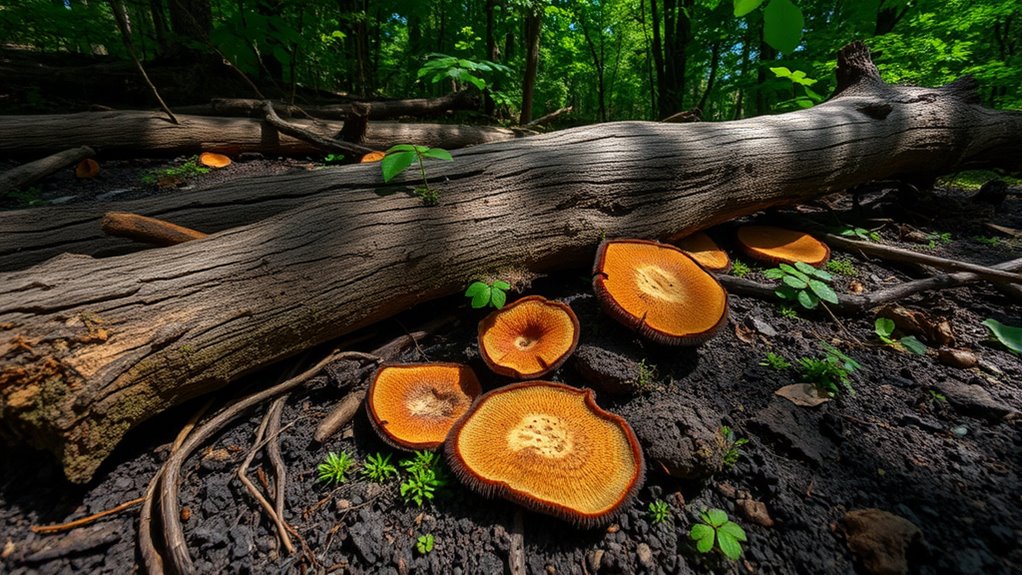
As deadwood decomposes, it plays a vital role in cycling nutrients back into the forest soil, enriching its fertility. Decomposition processes break down complex organic materials, releasing essential nutrients like nitrogen, phosphorus, and potassium. Microbial diversity drives these processes, with fungi, bacteria, and other microorganisms working together to decompose wood efficiently. The variety of microbes ensures a steady breakdown, preventing nutrient buildup and promoting soil health. As microbes consume deadwood, they transform nutrients into forms accessible to plants, supporting forest growth. This nutrient recycling maintains soil fertility over time, fostering a resilient ecosystem. Additionally, deadwood provides important habitat for many organisms, further contributing to ecosystem diversity. Proper management of deadwood can enhance soil nutrient cycling, which is crucial for maintaining forest productivity. The presence of deadwood also influences microbial activity, further accelerating nutrient availability. Without deadwood and its associated microbial activity, nutrient cycles would slow, impairing plant productivity and overall forest vitality. Moreover, the decomposition process creates microhabitats that support a wide range of invertebrate species, further enriching the biodiversity within forest ecosystems.
Deadwood and Forest Resilience

Because deadwood creates a diverse habitat within forests, it substantially enhances resilience against environmental stresses. As deadwood decomposes, it releases nutrients and supports a variety of organisms, strengthening the ecosystem’s stability. However, it can also serve as a pest habitat, potentially increasing vulnerability to pest outbreaks. To better understand its role, consider this table:
| Aspect | Benefit | Risk |
|---|---|---|
| Deadwood decay | Nutrient recycling | Pest habitat |
| Biodiversity | Supports diverse species | Disease spread |
| Ecosystem resilience | Buffers environmental shocks | Pest proliferation |
| Decomposition rate | Influences forest recovery | Pest habitat persistence |
| Forest health | Enhances overall stability | Increased pest pressure |
Recognizing these factors helps you appreciate deadwood’s dual role in fostering resilience and posing challenges.
Managing Deadwood in Conservation Efforts
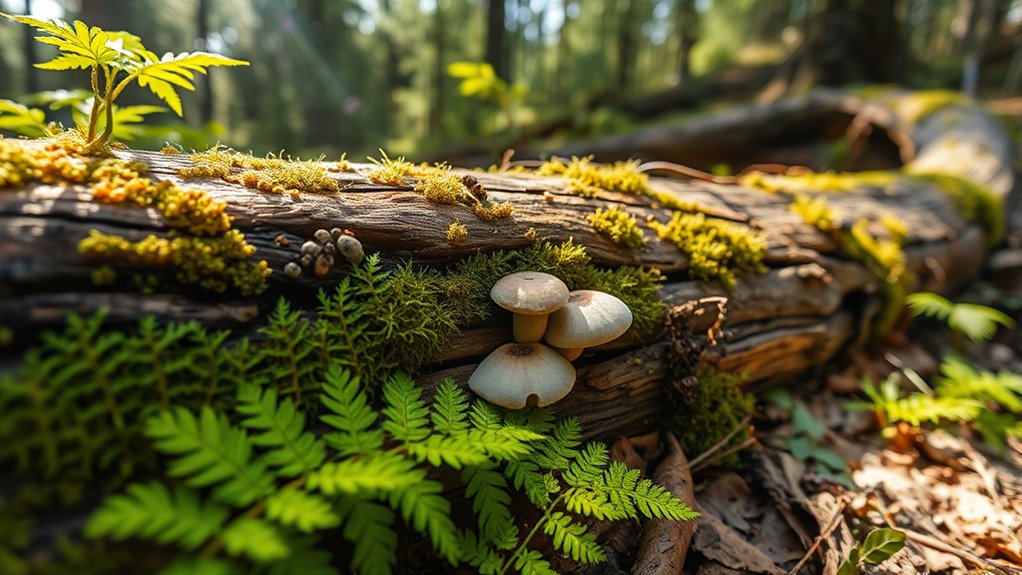
Effective management of deadwood is essential for balancing its ecological benefits with potential risks. You should evaluate when deadwood removal is necessary, especially in areas where it may pose fire hazards or harbor pests. Strategic deadwood removal, guided by sustainable logging practices, helps reduce these risks while maintaining habitat diversity. Avoid indiscriminate removal, as it can disrupt important ecological processes. Instead, focus on leaving sufficient deadwood to support biodiversity and natural decay cycles. Incorporate conservation goals into your planning, ensuring deadwood contributes to ecosystem resilience. Properly managed logging practices can balance the need for safety and ecological health, promoting a sustainable approach that benefits both the forest’s structure and its inhabitants. Additionally, understanding forests’ natural decay processes can inform more effective deadwood management strategies.
Frequently Asked Questions
How Does Deadwood Influence Fungal Diversity in Forests?
You might wonder how deadwood influences fungal diversity in forests. Deadwood provides a crucial substrate for fungal succession, where different fungi colonize and decay it over time. These decay processes promote a variety of fungal species, increasing overall diversity. As deadwood decomposes, it creates unique microhabitats, supporting specialized fungi and fostering a dynamic ecosystem. Your role in preserving deadwood helps maintain this rich fungal diversity essential for healthy forest ecosystems.
What Are the Economic Implications of Deadwood Removal?
You might think removing deadwood reduces forest clutter, but it has significant economic costs. Removing deadwood can negatively impact tourism, especially in eco-tourism areas where natural forests attract visitors. Additionally, it can lead to increased management expenses and loss of biodiversity that supports sustainable industries. You should consider these economic implications, as deadwood removal might save short-term maintenance costs but could harm long-term economic benefits tied to healthy, biodiverse forests.
Can Deadwood Help Combat Climate Change Effects?
Imagine a forest’s quiet skeleton, where deadwood acts like nature’s sponge, soaking up carbon and helping fight climate change. You can see how deadwood promotes carbon sequestration, locking carbon in place. It also preserves habitats for countless creatures, ensuring biodiversity. By leaving deadwood, you support the forest’s resilience, turning it into a natural climate ally—an essential step in mitigating climate change’s impacts.
How Do Different Tree Species Contribute to Deadwood Quality?
You might wonder how tree species influence deadwood quality. Different trees decay at varying rates, affecting how well wood decomposes and its contribution to the ecosystem. For example, hardwoods often decay slower, providing longer-lasting habitat, while softwoods decompose faster, enriching soil nutrients. Your choice of tree species impacts deadwood’s role in supporting biodiversity and carbon storage by shaping tree decay patterns and wood decomposition processes.
What Are the Challenges in Restoring Deadwood Habitats?
You face a tough challenge restoring deadwood habitats, and the stakes couldn’t be higher. Habitat fragmentation splits forests into isolated patches, making it harder for deadwood to support essential species. Invasive species threaten to outcompete native organisms, disrupting these delicate ecosystems. Overcoming these obstacles requires strategic efforts to reconnect fragmented areas and control invasive threats, ensuring that deadwood can fulfill its fundamental ecological roles once again.
Conclusion
So, next time you see fallen branches or rotting logs, remember they’re not just debris—they’re crucial for forest health. Ironically, what we often see as waste actually fuels biodiversity, nurtures soil, and bolsters resilience. By ignoring deadwood, we risk losing these hidden treasures. Embrace its role, and you’ll realize that in nature’s recycling bin, deadwood is the true cornerstone of thriving forests. Sometimes, the most overlooked elements are the most essential.
